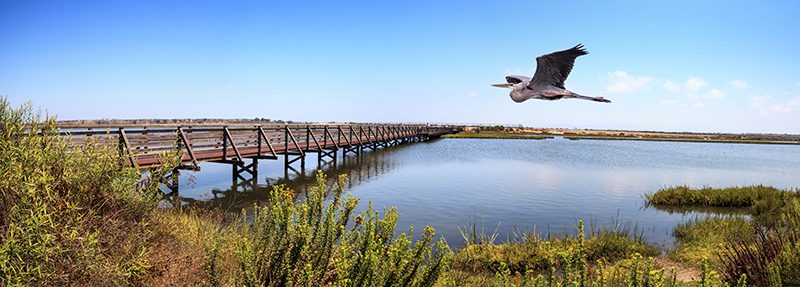Love Is In The Air. No, Wait, That’s CO2
A new study found that human activities such as marsh draining are leading to an increase of salt and freshwater wetlands being eaten away, but there is time to correct the problem.
HUNTINGTON BEACH- A study published May 6 by a team of Dutch, American, and German scientists found that it’s not too late to reverse the losses caused by marsh draining.
The paper’s authors say the road to success is using innovative restoration practices, identified in the new article, that replicate natural landscape-building processes and enhance the restored wetlands’ carbon-storing potential.
According to Brian R. Silliman, the Rachel Carson Distinguished Professor of Marine Conservation Biology at Duke University, who co-authored the study, nearly one percent of the world’s wetlands are disappearing each year due to pollution or marsh draining for agriculture, development, and other human activities.
Once the wetlands are disturbed, they release enormous amounts of CO2 from their soils, which account for about 5 percent of global CO2 emissions annually.
“Hundreds, even thousands of years of stored carbon are exposed to air and start to decompose and release greenhouse gases rapidly,” said Silliman in the study. “The result is an invisible reverse waterfall of CO2 draining into the atmosphere. The wetlands switch from being carbon sinks to sources. The good news is, we now know how to restore these wetlands at a scale that was never before possible and in a way that both stops this release of carbon and re-establishes the wetland’s carbon-storing capacity.”
What makes most wetlands so effective at carbon storage is that they are formed and held together by plants that grow close to each other, Silliman explained. A wetland’s dense above and below ground mats of stems and roots trap nutrient-rich debris and defend the soil against erosion or drying out, all of which help the plants grow better and allow the soil layer to build up, locking in more CO2 throughout the process.
In the case of raised peat bogs (a bog or bogland is a wetland), the process works differently, according to Silliman. Layers of living peat moss on the surface act like sponges by holding enormous amounts of rainwater that sustain its growth and permanently keep a thicker layer of dead peat moss below it. This prevents the lower layer of peat, which can measure up to roughly 33 feet wide, from drying out, decomposing, and releasing its stored carbon back into the atmosphere. As the living mosses gradually build up, the amount of carbon stored belowground continually grows.
Silliman believes successful restorations must replicate these processes.
“More than half of all wetland restorations fail because the landscape-forming properties of the plants are insufficiently taken into account,” said study co-author Tjisse van der Heide of the Royal Institute for Sea Research and the University of Groningen in the Netherlands in the study. “Planting seedlings and plugs in orderly rows equidistant from each other may seem logical, but it’s counter-productive.”
According to the study, restoration can be more successful when plants are placed in large dense clumps, when their landscape-forming properties are mimicked, or when large areas are restored on the first attempt.
“Following this guidance will allow us to restore lost wetlands at a much larger scale and increase the odds that they will thrive and continue to store carbon and perform other vital ecosystem services for years to come,” said Silliman. “The plants win, the planet wins, we all win.”
Silliman and van der Heide conducted the new study with scientists from the Netherlands’ Royal Institute for Sea Research, Utrecht University, Radboud University, the University of Groningen, the University of Florida, Duke University, and Greifswald University.
By synthesizing data on carbon capture from recent scientific studies, they found that oceans and forests hold the most CO2 globally, followed by wetlands.
“But when we looked at the amount of CO2 stored per square meter, it turned out that wetlands store about five times more CO2 than forests and as much as 500 times more than oceans,” says Ralph Temmink, a researcher at Utrecht University, who was the first author on the study.
Funding for the new study came from the Dutch Research Council, the Oak Foundation, Duke RESTORE, the Lenfest Ocean Program, the National Science Foundation, and Natuurmonumenten.
Southern California has prioritized wetland restoration. For example, the Bolsa Chica wetlands are a saltwater marsh in Huntington Beach that have undergone substantial restoration to avoid issues such as releasing carbon dioxide. The Bolsa Chica wetlands measure 1,449 acres; it is one of the most productive ecosystems on the planet, supporting large numbers of plants and animals, and are highly dynamic.
“The Bolsa Chica Ecological Reserve is a coastal saltwater marsh, so the only “draining” that occurs is the natural fluctuation in the water levels that results from the tides changing throughout the day,” said a Kirsten Haltman, an education program coordinator for the Bolsa Chica Conservancy in an email from May 11. “It is never artificially drained for any reason.”
While agriculture and development were once a threat to Bolsa Chica, the ecological reserve has been protected by state laws for the last 40 years. Therefore, it has not been used for those purposes for several decades. As a result, much of the reserve has already been restored to as close to original conditions (from the 1800s, before California became a state) as possible.
“The majority of restoration work done at Bolsa Chica is the removal of invasive species of plants (and sometimes installing native plants) and trash that can be harmful to the ecosystem,” said Haltman. “In addition to this work, the inlet located on the southern end of the reserve is dredged to allow proper flow of ocean water, but that is done by the State, not the Bolsa Chica Conservancy.”


